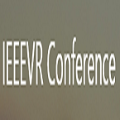Body actions and head gestures are natural interfaces for interaction in virtual environments. Existing methods for in-place body action recognition often require hardware more than a head-mounted display (HMD), making body action interfaces difficult to be introduced to ordinary virtual reality (VR) users as they usually only possess an HMD. In addition, there lacks a unified solution to recognize in-place body actions and head gestures. This potentially hinders the exploration of the use of in-place body actions and head gestures for novel interaction experiences in virtual environments. We present a unified two-stream 1-D convolutional neural network (CNN) for recognition of body actions when a user performs walking-in-place (WIP) and for recognition of head gestures when a user stands still wearing only an HMD. Compared to previous approaches, our method does not require specialized hardware and/or additional tracking devices other than an HMD and can recognize a significantly larger number of body actions and head gestures than other existing methods. In total, ten in-place body actions and eight head gestures can be recognized with the proposed method, which makes this method a readily available body action interface (head gestures included) for interaction with virtual environments. We demonstrate one utility of the interface through a virtual locomotion task. Results show that the present body action interface is reliable in detecting body actions for the VR locomotion task but is physically demanding compared to a touch controller interface. The present body action interface is promising for new VR experiences and applications, especially for VR fitness applications where workouts are intended.
翻译:人体动作和头部手势是虚拟环境中互动的天然界面。 现有机构内动作识别方法通常要求硬件多于头部显示器( HMD), 这使得普通虚拟现实用户难以引入身体动作界面, 因为他们通常只拥有 HMD 。 此外, 缺乏统一的解决方案来识别内部身体动作和头部手势。 这有可能会妨碍探索在虚拟环境中使用机构内动作和头部手势的新互动经验。 我们展示了一个统一的二流 1 - D convolual 神经网络( CNN), 以识别用户在行进式应用程序( WIP) 时的身体动作, 而当用户仍然只使用 HMD 时, 也难以向普通虚拟现实现实用户介绍身体界面( VMD ) 。 与以前的方法相比, 我们的方法并不需要专门硬件和/ 或头部手势手势动作比其他现有方法要多得多得多。 总共10个机构内动作和8个头手势手势( ) 与拟议的方法可以识别身体动作( WIP) 将这个工具界面显示一个随时可用的实物界面。 我们的手势动作动作显示一个组织内动作的动作, 行动界面, 显示一个可以显示一个动态界面。</s>



